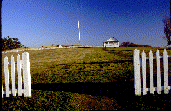|
 American Camp really began on a
grassy slope about 200 yards from the shoreline of Griffin Bay. That's where
Capt. George E. Pickett and Company D, 9th Infantry landed on July 27, 1859.
With the pitching of his first tent Pickett established an American military
presence on San Juan Island that lasted 14 years. American Camp really began on a
grassy slope about 200 yards from the shoreline of Griffin Bay. That's where
Capt. George E. Pickett and Company D, 9th Infantry landed on July 27, 1859.
With the pitching of his first tent Pickett established an American military
presence on San Juan Island that lasted 14 years.
English Camp and American Camp are part of:
San Juan Historical Parks, Click here for General Info!
It wasn't until the August 10 arrival of reinforcements under command of Lt.
Col. Silas Casey that the post found its permanent home. Casey decided to move
after two stormy nights at Pickett's second camp. The Virginian had changed
locations after only three days, perhaps in a quest for level ground but more
likely because of the British naval guns looking down his throat. Casey was not
impressed with the new site. "We are encamped in rather exposed situation
with regard to the wind, being at the entrance of the Straits of Fuca. The
weather at times is already quite inclement."
On August 22, Casey ordered his growing force (now 450 men) to pull up stakes
and relocate to the north slope of the ridge just north of the Hudson's Bay
Company barns -- once home to the pig that strayed and started the whole mess
two months before. Casey ordered large, conical Sibley tents shipped from Fort
Steilacoom to the new site which Casey deemed, "a very good position for an
entrenched camp." The tents would supplement the clapboard buildings
Pickett had already shipped over from Fort Bellingham, among these the hospital,
barracks, laundress and officers' quarters. The veteran colonel also ordered
Corps of Engineers 2nd. Lt. Henry Martyn Robert - later to achieve fame for his Rules
of Order -- to start work on a earthen fortification on the ridgetop east of
the new camp with a commanding view of both strait and bay. Meanwhile the
British riding at anchor in Griffin Bay were nothing short of impressed with the
colonel's enterprise.
"(Casey's camp) is very strongly placed in the most commanding position
at this end of the island, well sheltered in the rear and one side by the Forest
and on the other side by a Commanding eminence," wrote Capt. James Prevost,
commander of the H.M.S. Satellite.
As a deterrent, the post served its purpose until November when Lt. Gen.
Winfield Scott and British Columbia Gov. James Douglas finally agreed to a
peaceful joint occupation by a company from each nation until the boundary
dispute could be resolved. Casey and the bulk of the troops departed, along with
the artillery from the redoubt. One company remained.
And thus would the post continue through July 17, 1874. Eight companies from
four regiments -- all regular army and under command of 15 different officers --
would man the post through some of the most tumultuous years of American
history. They endured isolation, bad food, worse quarters and crushing boredom.
Some soldiers were willing to risk company punishment -- such as carrying a
40-pound log around the post all day -- to numb themselves with the rotgut
whisky of old San Juan Town. Some committed suicide. Some took "French
leave" (deserted). But most endured and by so doing contributed to the
legacy of peace we celebrate today.
The Forgotten Post
Lack of funds and pure neglect at times insured that American Camp changed
little over 14 years. Most of the buildings, including the blockhouse, were ship
shipped over from Fort Bellingham by George Pickett. The hospital Pickett first
erected at Spring Camp then moved to the new camp in August 1859. The Officer's
Quarters Pickett built in 1860 from Fort Bellingham lumber. It is one of only
two buildings standing on the site. The Fort Bellingham structures, and the
buildings constructed on site over the years, did not hold well. In fact,
conditions grew so bad that by 1867 the post commander begged for a new barracks
roof. The original roof had been constructed of green lumber and "it is now
become rotten -- almost uninhabitable, and irreparable," The officers
didn't have it any better. The two middle structures in officers' row were
"shells, battered on the inside, and owing to the exposed position of the
garrison, extremely uncomfortable and cold." One commander was
"compelled to allow the carpenters to sleep in the carpenter shop and
stable hands in stables." The Secretary of War denied all requests for
improvements.
English Camp and American Camp are
part of:
San Juan Historical Parks, Click here for General Info!
Back to Island Region Map |

